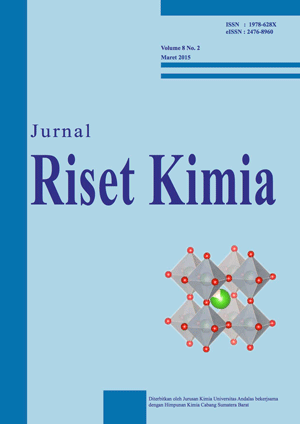PENGARUH BEBERAPA PERLAKUAN TERHADAP PENGURANGAN KADAR FORMALIN PADA IKAN YANG DITENTUKAN SECARA SPEKTROFOTOMETRI
DOI:
https://doi.org/10.25077/jrk.v8i2.238Keywords:
Formaldehyde, fresh fish, Nash reagent, UV-Vis spectrophotometryAbstract
The case of how handling the fresh fish which used the dangerous chemical material (formaldehyde) is still found in society, so that is why it is necesarry to find the safety way to handle the fresh fish in. It has been held the research about the influence of on the effect of some treatment in reduction the formaldehyde level on fish determined by spectrophotometry UV-Visible at wavelength 412 nm and 40°C. In the preliminary research the fish is soaked in formaldehyde liquid (100 mg/mL) for 24 hours, then washed, soaked and boiled. Then, the filtrate is reacted with Nash reagent. The yellow color which has formed was measured at λ 412 nm. The result shows there is the reduction of formaldehyde level in the sample about 43.9 % after washing, 33.3 % after soaking, 53.8 % after boiling. After that, the fish that was spread in the market which suspected containing the formaldehyde then washed, soaked and boiled. The result shows there is the reduction of formalin level in sample 1 about 22,7 % after washing, 17.0% after soaking, and 96.1 % after boiling. While in sample 2, 41.8 % after washing, 56.2 % after soaking, and 95.4 % after boiling.
References
Tunhun, Dusadee, Sombat K., Mayuree C. and Nongnuch R., 2008, Detection of Ilegal Addition of Formaldehyde to Fresh Fish, Faculty of Fisheries, Kasetsart University, Bangkok.
Adawyah R., 2007, Pengolahan dan Pengawetan Ikan, Bumi Aksara, Jakarta.
Levita J., Musfiroh I., Indriyati W., and Mustarichie R., 2010, The Effect of Soaking, Washing and Frying on The Concentration of Formaldehyde in Sange Belah Salty Fish, Jurnal Ilmu-Ilmu Hayati dan Fisik, 1, 12.
Aswad M., Fatmawaty A., Nursamsiar, dan Rahmawanti, 2011, Validasi Metode spektrofotometri sinar Tampak untuk Analisis Formalin Dalam Tahu. Majalah Farmasi dan Farmakologi, 1, 15, 26–29.
Cahyadi W., 2006, Analisis dan Aspek Kesehatan Bahan Tambahan Pangan, Bumi Aksara, Jakarta.
Li J., Zhu J., Ye L., 2007, Determination of Formaldehyde in Squid by High-Performance Liquid Chromatography, Asia Pacific Journal, 16, 127-130.
Aprilianti, Ayudiah, Ma’ruf A., Fajarini Z. N., Purwanti D., 2007, Studi Kasus Penggunaan Formalin Pada Tahu Takwa Di Kotamadya Kediri, PKM Penulisan Ilmiah (PKMI), Program Kreativitas Mahasiswa, Universitas Muhammadiyah Malang, Malang.
Hastuti S., 2010, Analisis Kualitatif dan Kuantitatif Formaldehid pada Ikan Asin di Madura, Agrointek,, 2, 4.
Mardiana, 2009, Pengaruh Perendaman dengan Air Mendidih dan Dingin Terhadap Kadar Formalin dalam Ayam Kemasan yang di Jual di Beberapa Supermarket di Kota Medan, Skripsi, Jurusan Kimia, Fakultas MIPA, USU, Medan.
Departemen Kesehatan Republik Indonesia. 1979. Farmakope
Schyver, S.B., 1910, The Photochemical Formation of Formaldehyde in Green Plants, Proc. Roy. Soc. London, Series B 82, 554, 227.
Nash, T., 1953, Colorimetric estimation of Formaldehyde By Means of Hantzch Reaction, Biochem, J, 55, 3, 417-418.
Susanti S., 2010, Penetapan Kadar Formaldehid Pada Tahu yang Dijual di Pasar Ciputat Dengan Metoda Spektrofotometri UV-Vis Disertai Kolometri Menggunakan Pereaksi Nash. Skripsi, Fakultas Kedokteran dan Ilmu Kesehatan, Universitas Muslim Negeri, Jakarta.
Harmita, 2004, Petunjuk Pelaksanaan Metode Validasi dan Cara Perhitungannya, Jurnal Ilmu Kefarmasian, 3, 1, 117–121.
Wu P., Chang C., and Chou S., 2003, Determination of Formaldehyde Incosmetics by HPLC Method and Acetyl Acetone Method. Journal of Food and Drug Analysis, 1, 1, 8–15.
Fessenden, R.J., dan Fesseden, J.S., 1997, Buku Terjemahan, Dasar - Dasar Kimia Organik, alih bahasa : Maun S., Anas K., Sally T.A, Binarupa Aksara, Jakarta, 361.
Lehotay J. and Hromulakova K., 1994, HPLC Determination of Trace Levels ofAaliphaticAldehydes C1-C4 in River and Tap Water Using Online Preconcentration. Journal Liquid Chromatography, 3, 17, 579.
Cahyadi W., 2006, Kajian dan Analilis Bahan Tambahan Pangan. Edisi Pertama, Pustaka Sinar Harapan, Jakarta.
Downloads
Published
How to Cite
Issue
Section
Citation Check
License
Please find the rights and licenses in Jurnal Riset Kimia (J. Ris. Kim). By submitting the article/manuscript of the article, the author(s) agree with this policy. No specific document sign-off is required.
1. License
The use the article will be governed by the Creative Commons Attribution license as currently displayed on Creative Commons Attribution 4.0 International License.Â
2. Author(s)' Warranties
The author warrants that the article is original, written by stated author(s), has not been published before, contains no unlawful statements, does not infringe the rights of others, is subject to copyright that is vested exclusively in the author and free of any third party rights, and that any necessary written permissions to quote from other sources have been obtained by the author(s).
3. User Rights
Under the Creative Commons license, the journal permits users to copy, distribute, and display the material for any purpose. Users will also need to attribute authors and J. Ris. Kim on distributing works in the journal and other media of publications.
4. Rights of Authors
Authors retain all their rights to the published works, such as (but not limited to) the following rights;
- Copyright and other proprietary rights relating to the article, such as patent rights,
- The right to use the substance of the article in own future works, including lectures and books,
- The right to reproduce the article for own purposes,
- The right to self-archive the article,
- The right to enter into separate, additional contractual arrangements for the non-exclusive distribution of the article's published version (e.g., post it to an institutional repository or publish it in a book), with an acknowledgment of its initial publication in this journal.
5. Co-Authorship
If the article was jointly prepared by more than one author, any authors submitting the manuscript warrants that he/she has been authorized by all co-authors to be agreed on this copyright and license notice (agreement) on their behalf, and agrees to inform his/her co-authors of the terms of this policy. J. Ris. Kim will not be held liable for anything that may arise due to the author(s) internal dispute. J. Ris. Kim will only communicate with the corresponding author.












